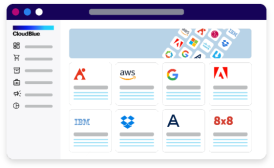Even before COVID-19 catalyzed the adoption of online B2B marketplaces, it was becoming apparent that marketplaces would be a key aspect of B2B sales in the years to come. Forrester had predicted that 17% of channel sales would flow through B2B marketplaces by 2023 — the pandemic’s acceleration of marketplace adoption led the consultancy to predict that figure would be hit this year.
On the operational side, the advantages of marketplaces include an additional channel to market and sell products, new sources of revenue, reduced marketing costs thanks to a built-in audience, and opportunities for overseas sales and new trading partnerships. From a customer-facing perspective, this translates to around-the-clock operation, and a better experience for customers as they can easily compare prices and products from a single source, which also leads to greater transparency.
Some of the world’s leading software companies have adopted marketplace strategies to great success. Perhaps the most-cited case is that of Salesforce, who in 2005 created AppExchange for third-party developers to create their own apps to sell to Salesforce customers. And GetApp and Capterra, both acquired by Gartner in 2015, are also among marketplaces that have proved highly successful. GetApp being a top online resource for businesses exploring software-as-a-service (SaaS) products, and Capterra serving as an intermediary between buyers and technology vendors within the software industry.
For CFOs looking to benefit from B2B marketplaces, it is important to have a sound strategy in place. A profitable marketplace strategy is based on this key economic principle: reaching economies of scale by increasing the units sold in relation to the operating costs. Or in other words, achieving a so-called fixed cost degression. Consequently, not all products, services, and markets are a good fit for a scalable marketplace strategy, and oftentimes, CFOs who are considering one don’t know where and how to evaluate the investment opportunity.
Let’s take a look at the three pivotal questions that CFOs and key financial decision-makers should ask themselves when evaluating a digital B2B marketplace strategy.
What type of market will we address with a B2B marketplace?
It may seem obvious, but businesses often overlook the key step of identifying and defining the type of market they wish to address with a B2B marketplace. Forgetting to do this vital step from the beginning can lead to detrimental mistakes down the road.
To best define the type of market a company should address with a B2B marketplace, CFOs need to partner with marketing to determine the industry their company is hoping to target, the overall size of the industry, and the total addressable market or TAM, which represents the total revenue opportunity available to a product or service.
The concept of TAM is crucial for companies as the estimates of the amount of effort and funding required enables them to prioritize specific products, customer segments, and business opportunities.
CFOs should also establish how saturated the market is at the moment, who the competitors are, and the weight those rivals have in the market. In addition, CFOs have to consider what size of companies and at which price they need to target with the B2B marketplace in order to outweigh the costs of goods sold and operating expenditures.
Having the answers to these questions in mind will help a company define its demographic and the investment requirements to set its digital marketplace strategy up for success.
What is the potential opportunity for growth within the market?
Once the target market is identified, the CFO must take steps to understand the potential growth opportunities for the company within that market via a marketplace strategy.
To do this, CFOs should estimate the total market potential and how much growth they can expect within a certain period of time (for example five years) within this market.
To forecast the total market potential for a product, a business first needs to define its target customers, estimate the total number of target customers, and determine a penetration rate for its product category or categories. It should also calculate the potential market size in terms of both volume and value and then modify its initial assumptions on a constant basis.
There are different processes through which a business can make a growth forecast, including customer surveys, expert opinions, estimates by salespeople, sales and trend analysis, and market tests.
Some of the other key areas companies should focus on include the competitive density of the market, the cost per unit sold on the marketplace, and the potential total revenue that can be made in the market.
It is also important to note the average transaction size for product segments within the market. This means if a company is reselling subscriptions to Microsoft Office 365 on a marketplace, for example, it must understand the cost of selling the product as well as the potential revenue per product it resells on the marketplace. This accurately determines the quantity of Office 365 subscriptions it must sell to actually turn a profit.
In general, the sweet spot for marketplaces is high transaction volume with low transaction size.
Are our goods and services scalable in a marketplace setting?
Once the CFO understands the market they wish to address and the growth opportunities within that market, it is time for them to introspectively look at the key products and services offered to see if these are scalable within a marketplace setting.
IT service providers, for instance, will often bundle software and services together to increase profitability that in turn provides more value to their end customers. To tap into this potential, CFOs must look at several key metrics to determine if the products and services are scalable to the marketplace. They also need to determine the Full-Time Equivalent (FTE) to units sold ratio. The ratio reflects the actual full-time payroll of the company and is especially important when companies want to compare themselves with industry standards or close competitors to determine whether they are understaffed or overstaffed.
Furthermore, they should ascertain whether the products and services they offer require a high amount of liquidity or capital costs (e.g. hardware). It is also important that they know if they can convert these costs and interests into an operating expense.
It is pivotal for CFOs to understand what resources they are using to sell, procure, and manage the products and services being sold on a marketplace. The longevity of these resources also need to be examined to know if they can hold strong to handle an increased amount of transactions. Finally, it is key to know whether the marketplace platform that the company is being paid on is based on units or if it claims parts of the businesses’ revenue.
The bottom line is that CFOs need to examine the components of their marketplace offerings and the underlying technology to make their products scalable. If they find the right way to build products, they can achieve tremendous economies of scale by boosting transaction volumes faster compared to the related operational costs—helping to consistently grow the company’s profit margin.












